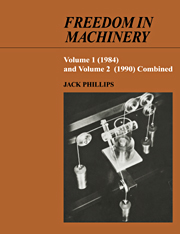Book contents
- Frontmatter
- Dedication
- Contents
- Preface
- General introduction
- 1 Mechanism and the mobility of mechanism
- 2 Overconstraint and the nature of mechanical motion
- 3 Some of the various lines in a moving body
- 4 Enumerative geometry and the powers of infinity
- 5 Rigidity and the instantaneous screw axis
- 6 Irregularity and the freedoms within a joint
- 7 The possibilities in reality for practical joints
- 8 Some elementary aspects of two degrees of freedom
- 9 The linear complex of right lines in a moving body
- 10 Line systems and the dual vectors in mechanics
- 11 Geometrical properties of the linear line systems
- 12 The vector polygons for spatial mechanism
- 13 On the two theorems of three axes
- 14 Some reciprocities across the middle number three
- 15 The generality and the geometry of the cylindroid
- 16 The discovery in a mechanism of a cylindroid
- 17 Action, notion, clearances and backlash
- 18 Singular events in the cycles of motion
- 19 Fundamental relations and some algebraic methods
- 20 The special geometry of some overconstrained loops
- 21 The helitangent lines in a moving body
- 22 The cylindroid in gear technology
- 23 The general and the special screw systems
- Bibliography
- Index of proper names
- Subject Index
2 - Overconstraint and the nature of mechanical motion
Published online by Cambridge University Press: 07 September 2010
- Frontmatter
- Dedication
- Contents
- Preface
- General introduction
- 1 Mechanism and the mobility of mechanism
- 2 Overconstraint and the nature of mechanical motion
- 3 Some of the various lines in a moving body
- 4 Enumerative geometry and the powers of infinity
- 5 Rigidity and the instantaneous screw axis
- 6 Irregularity and the freedoms within a joint
- 7 The possibilities in reality for practical joints
- 8 Some elementary aspects of two degrees of freedom
- 9 The linear complex of right lines in a moving body
- 10 Line systems and the dual vectors in mechanics
- 11 Geometrical properties of the linear line systems
- 12 The vector polygons for spatial mechanism
- 13 On the two theorems of three axes
- 14 Some reciprocities across the middle number three
- 15 The generality and the geometry of the cylindroid
- 16 The discovery in a mechanism of a cylindroid
- 17 Action, notion, clearances and backlash
- 18 Singular events in the cycles of motion
- 19 Fundamental relations and some algebraic methods
- 20 The special geometry of some overconstrained loops
- 21 The helitangent lines in a moving body
- 22 The cylindroid in gear technology
- 23 The general and the special screw systems
- Bibliography
- Index of proper names
- Subject Index
Summary
Transition comment
01. The broad matters discussed in chapter 1, namely those of freedom, mobility and the need for sufficient constraint in mechanism, are of great importance in the wide realm of practical machine design. They are derived however from a somewhat narrow set of assumptions regarding (a) rigidity in the absence of elasticity, (b) crookedness in the absence of accuracy, and (c) direct contact at joints in the absence of lubricated clearances. In chapter 1 there is thus developed what might be seen to be a somewhat simple theory of constraint. It is a simple theory; it is directly applicable; but only in a very rough way is it able to predict, for much of our ordinary machinery, the actual mechanical behaviour of the moving parts.
02. We often see in ordinary working machinery the unhappy effects of friction due to eccentricities of loading (§ 17.24), the consequent continuous likelihood of jamming, chatter, and wear, and the necessity for lavish lubrication at badly affected joints. Such phenomena will be evident whenever the kinematic design for a smooth transmission of the wrenches has been poor (§ 17.26), or, alternatively, whenever the jamming phenomena themselves have been an intended activity of the machine (§ 10.61). Although such matters are important and need to be studied, they are in a curious way irrelevant here. They are not the matters being implied at § 2.01.
- Type
- Chapter
- Information
- Freedom in Machinery , pp. 26 - 43Publisher: Cambridge University PressPrint publication year: 2007



